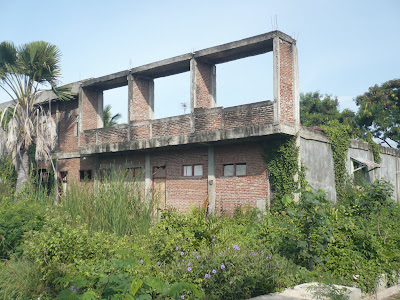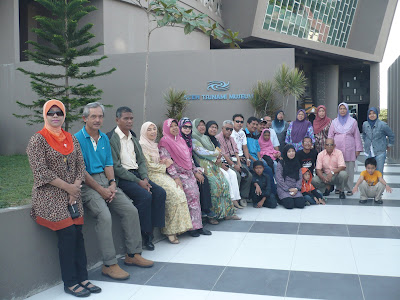Massal Mass Grave.
Massal Tsunami victim Mass Grave located at Jalan Bandara Sultan Iskandar Muda, Kampong Siron, Acheh Besar. It was the first Tsunami landmark along the road from the Airport heading towards Banda Acheh city. Forty six thousands seven hundred and eighteen (46,718) victims were buried in this mass graveyard. There is no tombstone except a white wavy painted wall with blue lining indicating as waves with Arabic script of “Kun Fayakun”. We stopped by to say each of our silent prayer of Al Fatihah simultaneously how bless we are in Malaysia situated distance away from the tectonic plate that can shift and cause earthquake sometimes followed by Tsunami.
The victim as it was found or recovered was just placed into the mass grave without being properly washed and given the last rite prayer. I really felt sorry for the victims and May Allah (GOD) Bless their immortal souls. Sometimes nature can be cruel but human plan but Allah (GOD) decides.

Fishing boat stuck on a roof.
Fisherman boat stuck on top of H, Misbah Lampulo house (bungalow) at Desa Lampulo, Kota Alam. Fifty nine (59) people were reportedly saved by boarding this small fishing boat and riding it to safety. Now it is a Tsunami Monument. Very dramatic and miraculous image when I saw it with my own eyes. Allah is great!! While stranded on board the stricken fishing boat on top of a house they managed to salvage drifted coconuts and quench their thirst. It was only about 1500 hrs in the afternoon the survivors dare to alight from the roof stuck fishing boat down to mother earth. The situation then was chaotic and Doomsday was coming.

PLTD Apung 1 washed inland.
Floating Electric Generator Vessel at Kampung Bunge Blangcut, Jayabaru. Weight: 2600 metric ton, Length: 19 meter Width: 9 meter. It was carried 3 km inland during the Tsunami. You can get a nice overview of the city from the top of the stranded vessel. When it was hit by the Tsunami of 26th December 2004, the PLTD Apung 1 broke it moorings. Originally the Power Station Vessel generating 10 megawatt for Banda Acheh by submarine cable was anchored 3 kilometer off shore. It was swept 3 kilo meter inland by the wave. Inhabitants of Banda Aceh clung to the vessel as it floated inland. All the eleven (11) crew on board originally survived but ten (10) came down and washed away by the second Tsunami wave, only one (1) survived who miraculously did not come down.
I simply cannot visualize how big the Tsunami wave was, when it could lift a 2600 metric ton weight of steel, 3 kilometer inland from 3 kilometer off shore. Only the power of Allah can do it.
A Tsunami Monument & Garden is located beside the electric generator Vessel PLTD Apung 1. Now it is a tourist attraction. The Monument was filled with photographs of tsunami victims which we in Malaysia were not shown. The pictures were so horrible that I shed my tears. I certainly not recommend for young children to view the photographs and I don’t have the heart feeling to capture with my camera. It was so touching.
Tsunami Ground Zero.
Ulee Lheue Banda Aceh (Tsunami Ground Zero). Ulee Lheue is a shore line facing the Malacca straits; when the tsunami hit Banda Aceh on 26 December, 2004, the beach line and the village nearby were severely damaged and submerged by a 10 m high wave. Now the local government has built a new seaport at Ulee Lheue, and a takeoff point to visit Sabang and Weh Island, by a Ro-Ro ferry or speed boat. Ulee Lheue beach has still kept its enchanting beauty, and almost every day people come to this place to enjoy the blue horizon of sky and sea, to see a beautiful sunset in the evening, or to enjoy the beach at night on the weekend.
The Japanese Government had built a wave breaker a few meters from the coastline and it is now a fishermen paradise sitting on the wave breaker. In the evening there are plenty of grilled maize vendors along the beach.
 At the distance, a ferry to Sabang Island. On the wavebreaker, a fisherman was fishing. The wave breaker was donated and constructed by the Japanese Government.
At the distance, a ferry to Sabang Island. On the wavebreaker, a fisherman was fishing. The wave breaker was donated and constructed by the Japanese Government.The Aceh Tsunami Museum was designed by Indonesian architect Ridwan Kamil. The Museum is a 2,500 m2 four-story structure; its long curving walls covered in geometric reliefs. Inside, visitors enter through a dark, narrow corridor between two high walls of water — meant to recreate the noise and panic of the tsunami itself. The museum walls are adorned with images of people performing the Saman dance, a symbolic gesture dedicated to the strength, discipline and religious beliefs of the Achenese. From above, the roof resembles a tidal wave. The ground floor is modeled on the kind of traditional raised Acehnese houses that were best equipped to survive the tsunami.
The building acknowledges both the victims, whose names inscribed on the wall of one of the Museum’s internal chambers, and the surviving members of the local community. In addition to its role as a memorial for those who perished, the Museum also offers a place of refuge from future such events, including an "escape hill" for visitors to run to in the event of another tsunami.
To be continued......................




































No comments:
Post a Comment